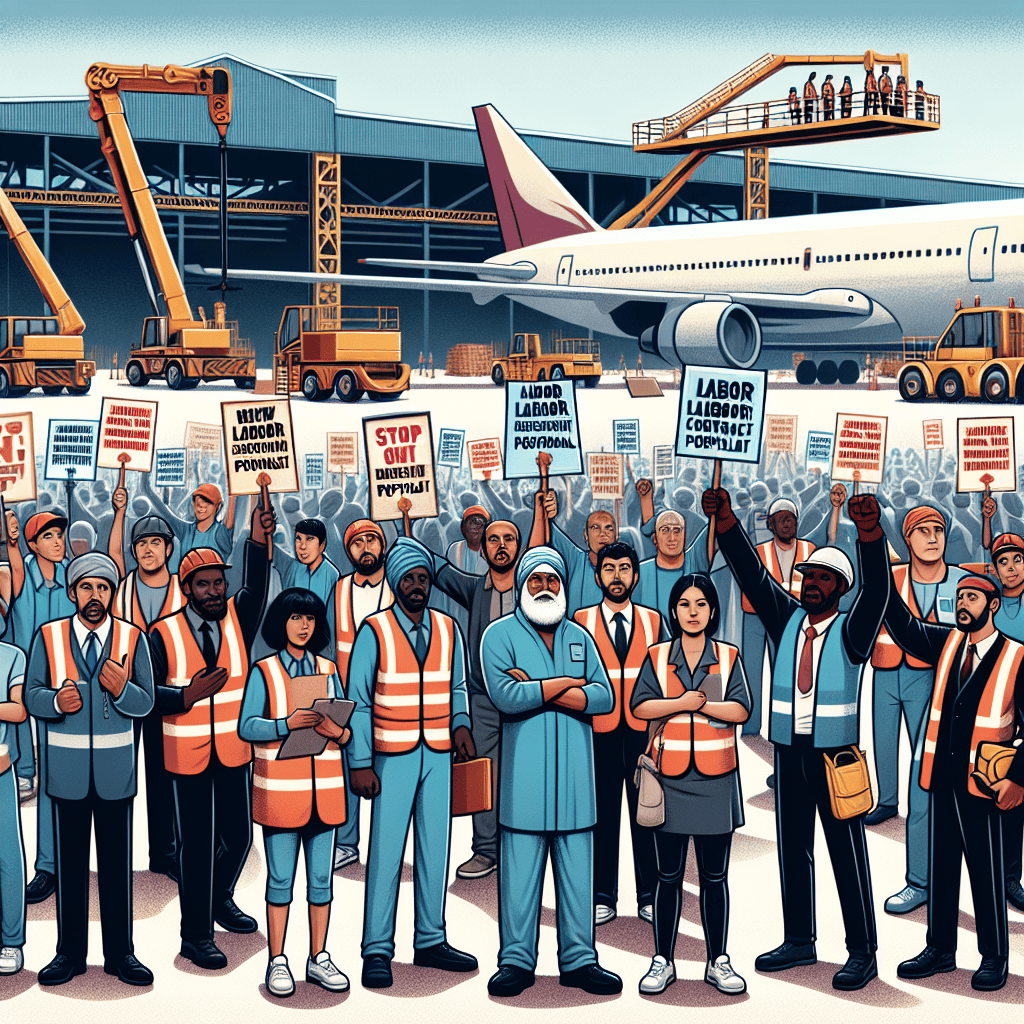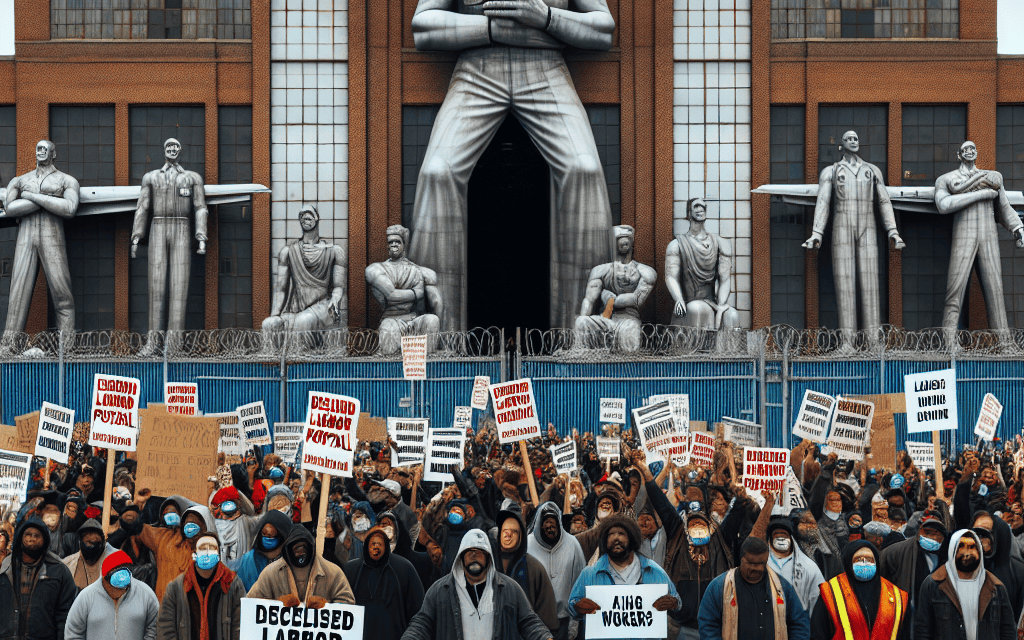“Unity in the Skies: Boeing Workers Stand Firm, Strike for Fairness”
Introduction
Boeing employees have rejected a new labor contract proposal, leading to the continuation of an ongoing strike. The decision reflects the workers’ dissatisfaction with the terms offered by the aerospace giant, as they seek better wages, benefits, and working conditions. The strike, which has garnered significant attention, underscores the growing tensions between labor forces and corporate management in the industry. As negotiations stall, the impact on Boeing’s operations and production schedules remains a critical concern, highlighting the broader implications for the company’s supply chain and market commitments.
Impact Of The Boeing Strike On The Aviation Industry
The ongoing strike by Boeing employees, following their decision to decline a new labor contract proposal, has sent ripples through the aviation industry, highlighting the intricate interdependencies within this global sector. As one of the largest aerospace manufacturers in the world, Boeing plays a pivotal role in the production and supply chain of commercial aircraft. Consequently, any disruption in its operations can have far-reaching implications, affecting not only the company itself but also airlines, suppliers, and passengers worldwide.
The refusal of the labor contract by Boeing employees underscores the growing tensions between labor and management, a dynamic that is not unique to Boeing but prevalent across various industries. The employees’ decision to continue the strike reflects their dissatisfaction with the terms offered, which reportedly include issues related to wages, benefits, and working conditions. This impasse has resulted in halted production lines, leading to delays in aircraft deliveries. For airlines, these delays translate into postponed fleet expansions or upgrades, potentially affecting their operational efficiency and capacity to meet passenger demand.
Moreover, the strike’s impact extends beyond immediate production delays. The aviation industry relies heavily on precise scheduling and coordination, and any disruption can lead to a cascading effect. Suppliers of aircraft components, who depend on Boeing’s production schedule, may face inventory backlogs or financial strain due to halted orders. This situation can further exacerbate the challenges faced by smaller suppliers, who may not have the financial resilience to withstand prolonged disruptions.
In addition to the supply chain ramifications, the strike also poses challenges for airlines already grappling with post-pandemic recovery efforts. As the industry strives to return to pre-pandemic levels of operation, the availability of new aircraft is crucial for meeting the anticipated surge in travel demand. Delays in aircraft deliveries could hinder airlines’ ability to capitalize on this recovery, potentially leading to increased operational costs and reduced profitability.
Furthermore, the strike highlights the broader issue of labor relations within the aviation industry. As companies navigate the complexities of a post-pandemic world, balancing cost management with employee satisfaction has become increasingly challenging. The Boeing strike serves as a reminder of the importance of addressing labor concerns proactively to prevent disruptions that can have significant economic and operational consequences.
While Boeing and its employees continue negotiations, the aviation industry watches closely, aware that the resolution of this strike will set a precedent for future labor relations within the sector. The outcome will likely influence how other aerospace companies approach labor negotiations, potentially shaping the industry’s labor landscape for years to come.
In conclusion, the ongoing Boeing strike underscores the interconnectedness of the aviation industry and the critical role that labor relations play in maintaining operational stability. As the strike continues, its impact reverberates through the supply chain, affecting airlines, suppliers, and ultimately, passengers. The resolution of this labor dispute will not only determine Boeing’s immediate production capabilities but also influence broader industry dynamics, highlighting the need for effective communication and negotiation strategies in addressing labor concerns. As stakeholders await a resolution, the strike serves as a poignant reminder of the delicate balance required to sustain the aviation industry’s growth and resilience.
Key Reasons Behind Boeing Employees Rejecting The Labor Contract
The recent decision by Boeing employees to reject the proposed labor contract has sent ripples through the aerospace industry, highlighting the ongoing tensions between the workforce and management. This development, which has resulted in the continuation of the strike, underscores several key reasons that have fueled the employees’ dissatisfaction with the proposed terms. Understanding these reasons is crucial to comprehending the broader implications for both Boeing and the industry at large.
First and foremost, one of the primary concerns among Boeing employees is the issue of wage stagnation. Despite the company’s significant profits and its pivotal role in the global aerospace market, many workers feel that their compensation has not kept pace with inflation and the rising cost of living. The proposed contract, while offering some wage increases, was deemed insufficient by the employees, who argue that it fails to adequately reward their contributions to the company’s success. This sentiment is particularly strong among long-term employees who have witnessed the company’s growth but feel left behind in terms of financial recognition.
In addition to wage concerns, the proposed contract’s provisions regarding job security have also been a major sticking point. In an industry characterized by cyclical demand and frequent restructuring, job security is a paramount concern for workers. The employees have expressed dissatisfaction with the contract’s lack of robust measures to protect against layoffs and outsourcing. This apprehension is exacerbated by recent trends in the industry, where companies have increasingly turned to subcontracting and automation to cut costs. Consequently, employees are seeking stronger assurances that their jobs will remain secure in the face of these challenges.
Moreover, the issue of benefits, particularly healthcare, has been another critical factor in the rejection of the contract. Employees have voiced concerns over rising healthcare costs and the proposed contract’s failure to address these adequately. The increasing burden of healthcare expenses on workers has been a contentious issue, with many employees feeling that the company should shoulder a greater share of these costs, especially given its financial standing. The perceived inadequacy of the proposed healthcare benefits has thus been a significant point of contention.
Furthermore, the employees’ decision to reject the contract is also rooted in a broader desire for improved working conditions. Many workers have highlighted issues such as long hours, insufficient breaks, and demanding production schedules as areas needing attention. The proposed contract, in their view, did not go far enough in addressing these concerns, leading to a sense of frustration and disillusionment. This desire for better working conditions is not only about immediate comfort but also about long-term health and well-being, which employees feel are being compromised.
In light of these factors, the continuation of the strike reflects a deep-seated demand for a more equitable and sustainable labor agreement. The employees’ rejection of the contract is not merely a reaction to specific terms but a call for a more comprehensive approach to labor relations that acknowledges their contributions and addresses their concerns. As the strike persists, it serves as a reminder of the critical importance of balancing corporate interests with the needs and aspirations of the workforce. The resolution of this impasse will require both parties to engage in meaningful dialogue and negotiation, with the hope of reaching an agreement that satisfies the legitimate demands of the employees while ensuring the continued success of Boeing in a competitive global market.
Historical Context: Previous Boeing Strikes And Their Outcomes
The recent decision by Boeing employees to decline a new labor contract proposal, thereby continuing their strike, is a significant event in the company’s history. To fully understand the implications of this ongoing strike, it is essential to examine the historical context of previous Boeing strikes and their outcomes. Over the decades, Boeing has experienced several labor disputes, each with its unique circumstances and resolutions, yet all contributing to the evolving relationship between the company and its workforce.
One of the most notable strikes in Boeing’s history occurred in 1995, when approximately 32,000 members of the International Association of Machinists and Aerospace Workers (IAM) walked off the job. This strike, which lasted 69 days, was primarily driven by issues related to job security and benefits. The resolution of this strike resulted in a contract that included improved job security provisions and a modest wage increase, setting a precedent for future negotiations. The 1995 strike underscored the importance of addressing employee concerns about job stability, especially in an industry subject to economic fluctuations and technological advancements.
Transitioning to the early 2000s, Boeing faced another significant labor dispute in 2005. This time, around 18,400 machinists went on strike for 28 days. The primary issues at stake were healthcare costs, pension plans, and job security. The resolution of this strike saw Boeing agreeing to maintain existing healthcare benefits and improve pension plans, highlighting the employees’ determination to protect their long-term financial security. This strike demonstrated the growing importance of healthcare and retirement benefits in labor negotiations, reflecting broader trends in the American workforce.
In 2008, Boeing experienced its longest strike in recent history, lasting 58 days and involving approximately 27,000 machinists. The central issues were again job security, healthcare, and pension benefits, but this time, the strike also focused on outsourcing concerns. The resolution included a four-year contract that provided wage increases, bonuses, and limits on outsourcing, illustrating the employees’ success in securing more favorable terms. This strike emphasized the increasing concern over globalization and its impact on domestic jobs, a theme that continues to resonate in labor discussions today.
The outcomes of these previous strikes have had lasting effects on Boeing’s labor relations. They have not only shaped the company’s approach to negotiations but also influenced the expectations and strategies of its workforce. Each strike has served as a learning experience for both parties, highlighting the need for effective communication and compromise. Moreover, these historical strikes have contributed to a broader understanding of the challenges faced by workers in the aerospace industry, particularly in balancing the demands of a competitive global market with the rights and needs of employees.
As the current strike continues, it is clear that the issues at hand are deeply rooted in the historical context of Boeing’s labor relations. The employees’ decision to reject the latest contract proposal suggests that their concerns remain unresolved, echoing the themes of job security, benefits, and outsourcing that have characterized past disputes. Understanding the outcomes of previous strikes provides valuable insights into the potential resolution of the current situation. It also underscores the importance of addressing the evolving needs of the workforce in an industry that is constantly changing. As negotiations continue, both Boeing and its employees will likely draw on the lessons of the past to navigate the complexities of the present, striving for a resolution that meets the needs of all stakeholders involved.
Economic Implications Of The Ongoing Boeing Strike

The ongoing strike by Boeing employees, following their decision to decline the new labor contract proposal, has significant economic implications that extend beyond the immediate parties involved. As the strike continues, it is essential to consider the broader economic landscape and the potential ripple effects on various sectors. The refusal of the contract proposal by the employees underscores a critical juncture in labor relations, highlighting the growing tensions between corporate management and the workforce. This development is not merely a localized issue but one that resonates across the national economy, given Boeing’s pivotal role in the aerospace industry.
Firstly, the strike has direct implications for Boeing’s production capabilities. With a substantial portion of its workforce on strike, the company faces inevitable delays in its manufacturing processes. This slowdown affects not only the delivery schedules of aircraft but also the supply chain that supports Boeing’s operations. Suppliers, many of whom are small to medium-sized enterprises, may experience reduced orders, leading to potential financial strain. Consequently, this disruption can cascade through the supply chain, affecting jobs and economic stability in regions heavily reliant on aerospace manufacturing.
Moreover, the strike’s impact on Boeing’s financial performance cannot be overlooked. Prolonged industrial action can lead to significant financial losses, affecting the company’s profitability and, by extension, its stock market performance. Investors, wary of the uncertainty surrounding the strike, may react by adjusting their portfolios, which could lead to fluctuations in Boeing’s stock price. This volatility can have broader implications for the stock market, particularly if investor confidence in the aerospace sector wanes.
In addition to the direct economic effects on Boeing and its supply chain, the strike also has implications for the broader labor market. The decision by Boeing employees to reject the contract proposal reflects a growing trend of labor activism across various industries. Workers are increasingly advocating for better wages, improved working conditions, and greater job security. This shift in labor dynamics could influence negotiations in other sectors, potentially leading to more widespread industrial action. As a result, businesses may need to reassess their labor strategies and consider the long-term implications of employee dissatisfaction.
Furthermore, the strike has potential ramifications for international trade. Boeing is a major player in the global aerospace market, and any disruption in its operations can affect international supply chains and trade agreements. Countries that rely on Boeing for aircraft and aerospace technology may face delays, impacting their own economic activities. This situation underscores the interconnectedness of the global economy and the importance of stable labor relations in maintaining international trade flows.
Finally, the ongoing strike highlights the need for effective communication and negotiation between employers and employees. As the situation unfolds, it is crucial for both parties to engage in constructive dialogue to reach a resolution that addresses the concerns of the workforce while ensuring the company’s long-term viability. The outcome of these negotiations will not only affect Boeing and its employees but also set a precedent for labor relations in the aerospace industry and beyond.
In conclusion, the Boeing strike, resulting from the rejection of the new labor contract proposal, has far-reaching economic implications. From production delays and financial losses to broader labor market trends and international trade impacts, the strike serves as a reminder of the complex interplay between labor relations and economic stability. As stakeholders navigate this challenging landscape, the importance of collaboration and compromise becomes increasingly evident.
Employee Perspectives: Voices From The Boeing Picket Line
The ongoing strike at Boeing has captured national attention, as employees continue to voice their dissatisfaction with the proposed labor contract. The decision to reject the new proposal was not made lightly, reflecting deep-seated concerns among the workforce about their future at the aerospace giant. As the strike persists, it is crucial to understand the perspectives of those on the picket line, whose voices reveal the complexities of the situation and the broader implications for labor relations in the industry.
Many employees have expressed that the proposed contract failed to address key issues such as wage increases, job security, and benefits. For instance, workers have highlighted that the offered wage adjustments do not keep pace with inflation, thereby eroding their purchasing power. This sentiment is echoed by numerous employees who feel that their hard work and dedication are not being adequately compensated. Furthermore, the proposal’s provisions on job security have been a significant sticking point. Employees are concerned about potential layoffs and outsourcing, which they believe could undermine their long-term employment prospects. This anxiety is compounded by the rapid technological advancements in the aerospace sector, which some fear could lead to further job displacement.
In addition to financial and job security concerns, the proposed changes to healthcare benefits have also been a major point of contention. Employees argue that the increased costs and reduced coverage would place an undue burden on their families. This issue resonates deeply with many workers, who view comprehensive healthcare as a fundamental right rather than a negotiable benefit. The dissatisfaction with the healthcare provisions has galvanized support for the strike, as employees seek to protect their access to essential services.
Moreover, the strike has fostered a sense of solidarity among the workforce, as employees from various departments and roles unite in their demands for a fair contract. This unity is evident on the picket line, where workers share their stories and support one another in their collective struggle. The camaraderie among employees has strengthened their resolve, as they remain steadfast in their pursuit of a contract that meets their needs and respects their contributions to the company.
The strike has also drawn attention to the broader labor movement, as other unions and workers express their support for Boeing employees. This solidarity extends beyond the aerospace industry, highlighting the interconnectedness of labor struggles across different sectors. The situation at Boeing serves as a microcosm of the challenges faced by workers nationwide, as they navigate an evolving economic landscape and advocate for their rights.
As negotiations continue, the voices from the picket line underscore the importance of addressing employee concerns in a meaningful way. The outcome of this strike will not only impact Boeing’s workforce but also set a precedent for labor relations in the industry. It is imperative for both parties to engage in constructive dialogue and work towards a resolution that acknowledges the legitimate grievances of employees while ensuring the company’s long-term viability.
In conclusion, the ongoing strike at Boeing is a testament to the power of collective action and the resilience of workers in the face of adversity. By listening to the voices from the picket line, we gain valuable insights into the challenges and aspirations of those who are at the heart of this labor dispute. As the situation unfolds, it remains to be seen how these perspectives will shape the future of labor relations at Boeing and beyond.
Negotiation Strategies: What Boeing Can Learn From The Strike
The ongoing strike by Boeing employees, following their rejection of a new labor contract proposal, underscores the critical importance of effective negotiation strategies in resolving labor disputes. As the strike continues to impact production and operations, Boeing is presented with an opportunity to reassess its approach to negotiations, drawing valuable lessons from the current impasse. Understanding the dynamics of this situation can provide insights into how the company might navigate future labor relations more successfully.
To begin with, the rejection of the contract proposal highlights the necessity for Boeing to engage in more comprehensive and transparent communication with its workforce. Employees often seek assurance that their concerns are being heard and addressed. By fostering an environment of open dialogue, Boeing can build trust and demonstrate its commitment to addressing the issues that matter most to its employees. This approach not only aids in understanding the workforce’s needs but also helps in crafting proposals that are more likely to gain acceptance.
Moreover, the strike emphasizes the importance of empathy in negotiations. Recognizing and validating the concerns of employees can significantly influence the outcome of discussions. Boeing can benefit from adopting a more empathetic stance, acknowledging the challenges faced by its workforce, and showing a willingness to find mutually beneficial solutions. This empathetic approach can help bridge the gap between management and employees, fostering a more collaborative atmosphere.
In addition to empathy, flexibility is a crucial component of successful negotiation strategies. The rigidity of contract terms can often lead to dissatisfaction and conflict. Boeing might consider adopting a more flexible approach, allowing for adjustments and compromises that address the evolving needs of its employees. By demonstrating a willingness to adapt and modify proposals, Boeing can create a more dynamic negotiation process that is responsive to the concerns of its workforce.
Furthermore, the strike serves as a reminder of the importance of timing in negotiations. Prolonged disputes can lead to significant financial and reputational damage. Therefore, it is essential for Boeing to recognize the urgency of resolving the strike and to act swiftly in addressing the core issues at hand. By prioritizing timely negotiations, Boeing can minimize disruptions and work towards a resolution that satisfies both parties.
Additionally, Boeing can learn from the strike by considering the role of third-party mediators in facilitating negotiations. Neutral mediators can provide an unbiased perspective, helping to identify common ground and propose solutions that might not be immediately apparent to either party. Engaging a mediator can also help de-escalate tensions and create a more constructive environment for dialogue.
Finally, the strike underscores the need for Boeing to invest in long-term relationship-building with its employees. Beyond the immediate resolution of the current dispute, Boeing should focus on creating a culture of collaboration and mutual respect. By investing in ongoing communication and engagement initiatives, Boeing can strengthen its relationship with its workforce, reducing the likelihood of future conflicts.
In conclusion, the ongoing strike at Boeing presents a valuable opportunity for the company to refine its negotiation strategies. By prioritizing transparent communication, empathy, flexibility, timely action, and long-term relationship-building, Boeing can navigate the complexities of labor relations more effectively. These lessons, drawn from the current impasse, can serve as a foundation for more successful negotiations in the future, ultimately benefiting both the company and its employees.
Future Projections: How The Boeing Strike Could Shape Labor Relations
The ongoing strike by Boeing employees, following their decision to decline the latest labor contract proposal, has significant implications for the future of labor relations within the aerospace industry and beyond. As the strike continues, it is essential to consider how this situation might influence labor negotiations, employee-employer dynamics, and the broader economic landscape in the coming years. The refusal of the contract proposal by Boeing employees underscores a growing trend of labor assertiveness, reflecting a broader movement among workers to demand better working conditions, fair wages, and comprehensive benefits. This development is not isolated; rather, it is part of a larger narrative where employees across various sectors are increasingly willing to leverage collective bargaining power to achieve their goals. Consequently, the Boeing strike could serve as a catalyst for similar actions in other industries, potentially leading to a reevaluation of labor practices and policies.
Moreover, the strike highlights the critical role of effective communication and negotiation in labor relations. As Boeing and its employees remain at an impasse, it becomes evident that successful labor negotiations require a mutual understanding of priorities and a willingness to compromise. This situation may prompt companies to adopt more transparent and inclusive negotiation strategies, fostering a collaborative environment that prioritizes the needs and concerns of both parties. In the long term, such an approach could lead to more sustainable labor agreements, reducing the likelihood of future strikes and disruptions.
In addition to influencing negotiation strategies, the Boeing strike may also impact the perception of labor unions and their role in advocating for workers’ rights. As employees continue to push for improved conditions, unions are likely to gain increased visibility and support, potentially leading to a resurgence in union membership and activity. This shift could empower workers to have a more significant voice in shaping their work environments, ultimately contributing to a more balanced power dynamic between employers and employees.
Furthermore, the economic implications of the Boeing strike cannot be overlooked. As one of the largest aerospace manufacturers globally, Boeing plays a crucial role in the supply chain and the broader economy. The prolonged strike could lead to production delays, affecting not only Boeing’s bottom line but also the numerous suppliers and businesses that rely on its operations. This potential disruption underscores the importance of resolving labor disputes promptly and effectively to minimize economic fallout.
Looking ahead, the Boeing strike may also prompt policymakers to reevaluate labor laws and regulations, considering potential reforms to better address the evolving needs of the workforce. As labor relations continue to evolve, there may be increased calls for policies that promote fair labor practices, protect workers’ rights, and encourage constructive dialogue between employers and employees. Such reforms could help create a more equitable and resilient labor market, benefiting both workers and businesses in the long run.
In conclusion, the ongoing Boeing strike serves as a pivotal moment in labor relations, with the potential to shape future negotiations, union dynamics, and economic policies. As the situation unfolds, it will be crucial for all stakeholders to engage in open and constructive dialogue, seeking solutions that address the concerns of both employees and employers. By doing so, the aerospace industry and other sectors can pave the way for more harmonious and productive labor relations, ultimately contributing to a more stable and prosperous economic future.
Q&A
1. **What is the main issue causing the strike among Boeing employees?**
The main issue is the rejection of a new labor contract proposal, which employees feel does not meet their demands for better wages, benefits, or working conditions.
2. **How long has the strike been ongoing?**
The duration of the strike varies depending on the specific situation, but it typically continues until a satisfactory agreement is reached between Boeing and the employees.
3. **What are the key demands of the Boeing employees?**
Key demands often include higher wages, improved healthcare benefits, better retirement plans, and enhanced job security.
4. **Which union represents the striking Boeing employees?**
The International Association of Machinists and Aerospace Workers (IAM) is commonly the union representing Boeing employees in labor disputes.
5. **How has Boeing responded to the strike?**
Boeing usually responds by attempting to negotiate with the union, proposing revised contract terms, and sometimes hiring temporary workers to maintain production.
6. **What impact does the strike have on Boeing’s operations?**
The strike can lead to production delays, financial losses, and disruptions in the supply chain, affecting Boeing’s ability to meet delivery schedules.
7. **What are the potential outcomes of the strike?**
Potential outcomes include reaching a new agreement that satisfies both parties, continued negotiations, or, in some cases, legal intervention to resolve the dispute.
Conclusion
The rejection of the new labor contract proposal by Boeing employees, resulting in the continuation of the strike, underscores significant dissatisfaction with the terms offered by the company. This decision highlights ongoing tensions between the workforce and management, likely centered around issues such as wages, benefits, job security, and working conditions. The continuation of the strike suggests that employees are willing to endure financial and operational disruptions to achieve a more favorable agreement. This impasse may impact Boeing’s production schedules and financial performance, emphasizing the need for both parties to engage in further negotiations to reach a mutually acceptable resolution.





